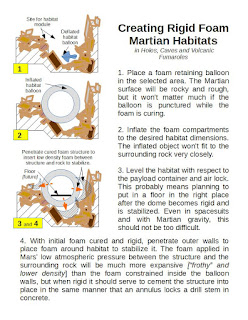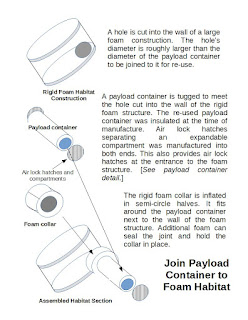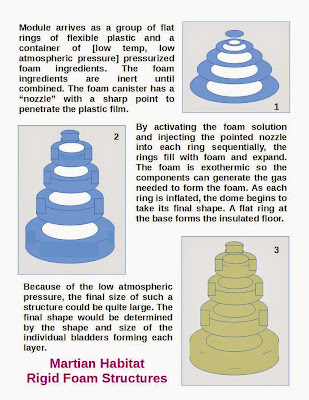A Few More Engineering Design Suggestions and Diagrams
for Establishing the Mars Habitat
for Establishing the Mars Habitat
1. Preparing and moving material into the BioMass
Astronauts will be facing the task of moving sewage or manually shredding green house trimmings for addition to the BioMass tank. To make this task easier while avoiding as much transport weight as possible, equip them with a manually operated nylon screw assembly which can be inserted in each feed pipe. It is unlikely that this can be accomplished by gravity because the camp will be sited on a level field. Steps must also be taken to avoid introducing a vacuum at the habitat end of a sewer pipe.
2. Piping Insulation and Heat Trace
Generally, habitat structures should be located in fairly close proximity to each other, yet some pipe runs may still be necessary. These should be heat traced and insulated sufficiently to withstand the Martian surface temperatures. An additional consideration may be to jacket the insulation surrounding the pipes with UV protection to prevent deterioration of the insulation foam.
If electrical conductors need to be routed to the same destinations, they can be kept warm by being placed in a channel next to the carrier pipe shown in the pipe section detail. There may be metal fatigue, excessive "brittleness" [extreme cold can strip the carbon out of steel exposed to it], or other deterioration in conductor material at Martian surface temperature. No one wants to be the guy looking for a broken wire somewhere on the surface of Mars.
For gas piping the runs would still need to be insulated, but insulated victaulic connections made for the Martian equivalent to PVC could be used for closer containment integrity. The low atmospheric pressure [high differential pressure between inside and outside of pipe] will aggravate the potential for small leaks even when internal pipe pressure is relatively low.
For gas piping the runs would still need to be insulated, but insulated victaulic connections made for the Martian equivalent to PVC could be used for closer containment integrity. The low atmospheric pressure [high differential pressure between inside and outside of pipe] will aggravate the potential for small leaks even when internal pipe pressure is relatively low.
3. Designing Payload Containers for Re-Use
The "alternative" to re-using payload containers is the resulting necessity of transporting significant numbers of air lock and double hatch components to be installed in habitat structures. Complete air lock assemblies could be built into the standard design for mission payload containers. Depending on the final size the containers will take, they offer ready made additions to habitat quarters.
If they are too small for a human to walk through them, they can be made for easy dis-assembly with the air locks used for habitat and the remainder used for storage -- certainly including gas storage containers once they are sealed again.
The standard design should include manufacturing modifications which will make it easier for men in space suits with come-alongs to move them. The standard design should also include insulation and radiation shielding.
4. Constructing large foam habitat structures on site
There will be a difficult shortage of room unless structures can be manufacturing on Mars. The "rigid foam in a balloon" scheme seems to be the most effective way to accomplish this while reducing the manual work and time required for alternate methods. The diagram suggests a means to anchor and stabilize such structures while taking advantage of local features of the Martian surface.
Although there are dust storms, the Martian "wind" is much less of a structural problem than on Earth thanks to the low inertial mass of the extremely rarefied atmosphere. However, UV radiation, high for the same reason, could degrade the foam material over time with continuous exposure. This would require a UV protection to be incorporated in the "balloon" shell, but this will only be a materials problem.
5. Connecting Payload Containers to Foam Habitats
Without having to bother with the details -- and work -- of dragging an air lock hatch assembly from where it landed over to a newly made foam structure and installing it, a re-used payload cargo container could add a small amount of "bonus" floor space and two fully assembled air lock hatch sets.
Likewise, payload containers with an air lock hatch and chamber set built into both ends can be used to connect one foam structure to another. This arrangement makes it possible to isolate individual habitat areas in the event of a micro-meteor penetration in one of them.
Connecting a used container could actually be easier than installing a separate air lock in the wall of a rigid foam structure. In addition to the built in air lock sets, payload containers could be manufactured to include easy, ready made connections for habitat air and electricity. The air locks could also be detached from the containers if necessary for installation in spots where there was no room for a full container.
The rigid foam habitat structures could have holes carved into them to receive a container with something like an electric chain saw able to operate at Martian temperatures. The foam collar connection is straight from Arctic designs only with significantly thicker foam insulation. It is a very sensible design which makes creating an atmospheric seal much simpler.
After living in a space ship and the Mars orbital station for months Mars humans might really appreciate an actual commode. Once the camp's water supply has had the time to build up a solid surplus, such a thing would be quite reasonable although it might still require a few "design adjustments" to integrate with the BioMass "sewage system" and internal atmosphere requirements. The tightly closed habitats will definitely require an aggressive air purification system. There cannot be any vents releasing habitat environmental air into the Martian atmosphere.
There is no such thing as "fresh air" on Mars. All the air in the habitat will be air generated by the reactor hydrolysis, and it will be constantly used and reused. Without constant and aggressive air purification and treatment habitat air will inevitably develop an almost intolerable stench.
Along with the commode the Martian humans could also very reasonably construct something similar to a "hot shower" and even a small steam sauna. Working in the Arctic for an extended period made such things not only very attractive, but showers and sauna also served as necessary tools to maintain health. In the Arctic during winter the humidity was almost zero, but the ambient humidity on the Martian surface is zero. Even with a humidifier inside the habitat, the humidity will remain low.
7. Nitrogen
It is an almost automatic response to the habitat's environmental requirements to turn the attention to oxygen. However, oxygen's "quiet sister" presents a quite different yet equally important challenge. On the day the Earth men arrive they will be breathing air containing nitrogen [N2] brought from Earth. However, by the time the first large foam habitat structures are in place there will be a requirement for lots of nitrogen to prepare those environments.
[The trace gases in Earth-like atmosphere can reasonably be shipped to Mars in a pressurized tank. Even a small supply could fulfill these requirements for a long time.]
Short Term: Produce large initial quantities of N2 on Mars
CURIOSITY found significant amounts of ionic nitrate compounds in Martian dust which could be released in gas form [N2] by applying heat. There will almost certainly be other gases released in this process, but defining the task of purifying the nitrogen will depend on having a better picture of what else is expected to be released in the process.
Applying this much heat energy from an electrical source such as the Stirling generators may be a problem. Although this could definitely be done, it might take a long time to produce the amounts of nitrogen gas needed. An alternate plan would use reactor heat directly through a high temperature heat exchanger.
An obvious possibility is to use the "module environment" heat exchanger. While the long term purpose of this is to provide the reactor module with an internal heat source to "host" the generator sets, it could be diverted to "nitrogen generation duty" long enough to produce sufficient nitrogen to initially provide for the habitat structures.
The physical/mechanical requirements would be relatively simple. Martian soil could be placed in a closed vessel near the reactor module with the heat exchanger connected. The NO3 - N2 process could be approached almost passively -- with the possible exception of some sort of slowly rotating baffle to continuously bring soil from the bottom to the warmer layers at the top. The N2 being generated this way would already bring the benefit of being at a significantly higher gas pressure than Martian atmospheric pressure so it would flow through the vessel's exhaust port to the habitat more or less on its own without requiring a pump.
This process would not be a rapid one. However, the mechanics required for it could be probably be set up and initiated robotically prior to the arrival of the humans.
Long Term: Establish self sustaining nitrogen cycle for the habitat
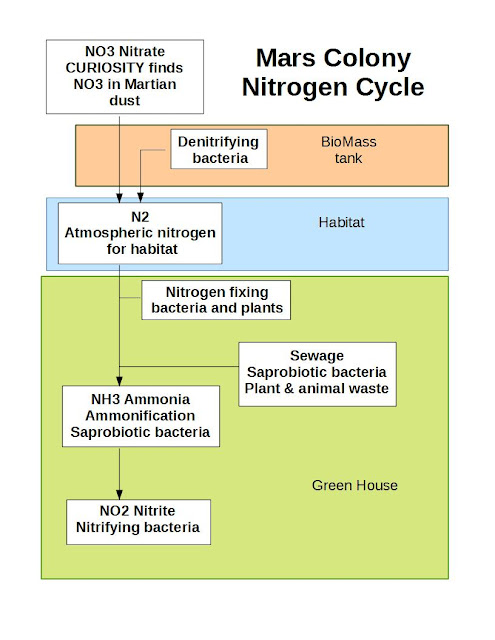 |
| Habitat/Green House Nitrogen Cycle |
While there is not a shortage of the feed stock materials to produce nitrogen for the habitat atmosphere, the additional needs of the green house process will demand even more forms, primarily as ionic compounds needed for plant life. Given time, the habitat's nitrogen cycle can balance the consumption and output by all "participants," but it will not do so as a "forgiving coincidence."
Generating sufficient nitrogen for human habitat requirements will be the first task, proceeding before BioMass and green house priorities. If we were to eliminate the lower half of the Habitat Environmental Nitrogen Chart, we would see conditions existing at the time of first arrival of humans.
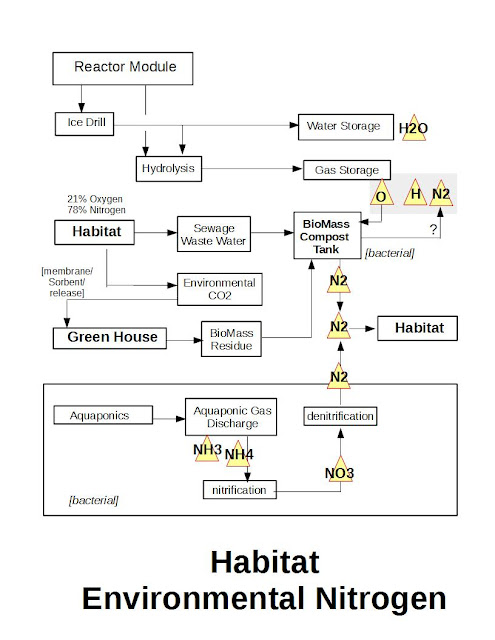
The initial generation of N2 from Martian soil can satisfy the habitat's initial requirements. However, to permanently sustain the habitat's environment a continuous source of additional N2 will need to be generated by habitat systems. A combination of a BioMass "composting" tank, a functioning aquaponics tank and a hydroponic green house can accomplish this.
The Habitat Environmental Nitrogen diagram illustrates roughly the process which will need to gradually become established for this purpose. Although it will never be possible to precisely control the size of the populations of nitrification and denitrification bacteria, once these composting processes have been initiated with bacteria imported from Earth, the system should function fairly autonomously. Importantly, it will also "scale up" easily to accommodate a larger green house or additional human residents.
Generating sufficient nitrogen for human habitat requirements will be the first task, proceeding before BioMass and green house priorities. If we were to eliminate the lower half of the Habitat Environmental Nitrogen Chart, we would see conditions existing at the time of first arrival of humans.

The initial generation of N2 from Martian soil can satisfy the habitat's initial requirements. However, to permanently sustain the habitat's environment a continuous source of additional N2 will need to be generated by habitat systems. A combination of a BioMass "composting" tank, a functioning aquaponics tank and a hydroponic green house can accomplish this.
The Habitat Environmental Nitrogen diagram illustrates roughly the process which will need to gradually become established for this purpose. Although it will never be possible to precisely control the size of the populations of nitrification and denitrification bacteria, once these composting processes have been initiated with bacteria imported from Earth, the system should function fairly autonomously. Importantly, it will also "scale up" easily to accommodate a larger green house or additional human residents.
The diagram also posts a question mark on the necessity for storing surplus N2 along with the other hydrolysis products. A few reasonable estimates for the initial habitat's floor space and the rate at which N2 can be produced will determine whether or not it will be necessary to generate and store reserve surpluses of it. When projects designed for greater habitat floor space or higher residency are begun in the future, a slowly developed surplus of available N2 will be required. Further, we can assume that the habitat structures will "leak" habitat atmosphere, and although these "leaks" might be quite small, replacement atmospheric gases will be required from time to time.
Is an Aquaponics System really practical?
Right away this contest's admonition about "unworkable suggestions" casts a shadow on the aquaponics idea. However, all the complications and cost of shipping an aquaponics tank, not to mention the necessary live fish, may well be justified by the increased efficiency and productivity of a hydroponic green house which is supplied by aquaponic nutrients, especially dissolved forms of nitrogen from an aquaponic source.
Food production rates in a hydroponic Martian green house can make or break both the permanence and the sustainability of this mission. If the addition of a modest aquaponics tank could increase green house food production by even as little as 10% - 15%, the idea's merit becomes much more attractive.
The idea of operating and maintaining a BioMass system almost seems contradictory to work one might normally associate with being an astronaut living on another planet, but when there is no "default BioMass" system whatsoever already in place and easily accessed, the critical and unavoidable importance of that tank of smelly, bubbling, bacterial, decomposing matter quickly becomes clear.
There will be a role for Martian soil even in the hydroponic green house process. Mixing the distinctively "Earthly" BioMass with native soil might be tricky, but it will become necessary as the demand for both larger quantities and wider varieties of "local" food increases. There are currently and will, very likely, continue to be questions about the details of what is contained in Martian soil. In this case those questions will center on the impact that extra-terrestrial mix will have on living Earth plants.
An obvious first possibility for acquiring quantities of Martian soil in an "un-frozen" state will be the re-use of the slurry and sediment discarded during reactor liquefaction of ice drill returns.
Still, we can see the important role which will be played by the habitat's BioMass itself -- beginning with its part in maintaining habitat N2 levels, but extending immediately to the production of "soil materials" suitable for the hydroponic process in the green house. On Earth humans are quite selective in deciding what might be added to a compost. On Mars that question has a direct answer: absolutely everything possible.
The Mars habitat may, as time passes, have a "landfill" of sorts, but it will be a very, very small one. It will cost $10,000 per kilogram to transport something there to thrown into it.
There will be a role for Martian soil even in the hydroponic green house process. Mixing the distinctively "Earthly" BioMass with native soil might be tricky, but it will become necessary as the demand for both larger quantities and wider varieties of "local" food increases. There are currently and will, very likely, continue to be questions about the details of what is contained in Martian soil. In this case those questions will center on the impact that extra-terrestrial mix will have on living Earth plants.
An obvious first possibility for acquiring quantities of Martian soil in an "un-frozen" state will be the re-use of the slurry and sediment discarded during reactor liquefaction of ice drill returns.
Still, we can see the important role which will be played by the habitat's BioMass itself -- beginning with its part in maintaining habitat N2 levels, but extending immediately to the production of "soil materials" suitable for the hydroponic process in the green house. On Earth humans are quite selective in deciding what might be added to a compost. On Mars that question has a direct answer: absolutely everything possible.
The Mars habitat may, as time passes, have a "landfill" of sorts, but it will be a very, very small one. It will cost $10,000 per kilogram to transport something there to thrown into it.
Perhaps its most "Earth-like" feature of the BioMass will be the simple fact that it is not under the control of carefully developed planning, but instead, represents the apparently "nicely" chaotic nature of Earthly Great Nature "herself."
Every scrap of everything humans are importing, consuming or discarding should be a candidate for addition to the BioMass. The nature of things destined to be transported to the Mars colony must reflect this. There won't be water for washing clothes, so make bundles of coveralls from biodegradable paper which can be digested after use. The design of every package used for shipping anything to Mars should include the possibility of its ultimate dissolution into some kind of usable residue in the BioMass.
Likewise, many of the microscopic "inhabitants" of a functioning BioMass are going to end up there through a very natural "Mother Earth" style sequence of coincidence, over sight and accident even though every one of these has been hauled all the way to Mars. Count on it. Future Martian "residents" will look back on the requirement of making sure that rovers were completely sterile as being a very curious idea.
Part of the green house must ultimately be devoted to algae beds. The reasons are obvious.
Part of the green house must ultimately be devoted to algae beds. The reasons are obvious.
When the sustainability process has settled into some sort of routine, mission controllers will be facing questions about adding such things as moss, rodents, houseflies, bees and mosquitoes to the mix. It is already clear that pollinators will be an early necessity for a functional green house. In time perhaps common farm yard creatures such as rabbits or chickens can be introduced into the biological mix -- and into the diets of astronauts hungry for a taste of "Earth food."
Considering the aquaponic tank, the BioMass tank and the green house as a single "biological" system, a serious Martian environmental problem emerges. Agricultural food production, life in the BioMass tank, the green house component of oxygen production, fish in the aquaponic system and any stray Earth creatures such as chickens or rabbits can be lost almost instantly if exposed to external Martian atmospheric pressure or temperatures.
Although the "living elements" of these will be destroyed, the chemical contents could be thawed and "re-populated" if there were another, parallel system which remained undamaged. Such a parallel system would also have to be complete, containing each of the components. This compartmentalized approach reinforces the "two of everything" idea, and the parallel system be a "future plan," it will need to be constructed simultaneously with the first system.
Considering the aquaponic tank, the BioMass tank and the green house as a single "biological" system, a serious Martian environmental problem emerges. Agricultural food production, life in the BioMass tank, the green house component of oxygen production, fish in the aquaponic system and any stray Earth creatures such as chickens or rabbits can be lost almost instantly if exposed to external Martian atmospheric pressure or temperatures.
Although the "living elements" of these will be destroyed, the chemical contents could be thawed and "re-populated" if there were another, parallel system which remained undamaged. Such a parallel system would also have to be complete, containing each of the components. This compartmentalized approach reinforces the "two of everything" idea, and the parallel system be a "future plan," it will need to be constructed simultaneously with the first system.
Aside from managing to control habitat carbon dioxide levels, creating the first Martin tomato and a supplying a constant flow of habitat oxygen, green house lights can provide an alternative to the sunlight exposure required by humans on Earth.
8. Carbon dioxide
Beyond the oxygen and nitrogen requirements continuous human presence in the habit will also introduce a carbon dioxide challenge. The optimum place for an excessively high carbon dioxide concentration will be in the hydroponic green house, but this will require a method by which excess carbon dioxide can be captured in the habitat living quarters and later released in the green house atmosphere where it can be consumed by plants which will, in turn, augment the available oxygen levels.
Carbon dioxide levels in the green house should not be allowed to become so high that humans could not enter without masks. "Self sustaining" necessarily means "balanced." The green house will require a substantial amount of manual work.
There is existing CO2 collection technology in use on nuclear submarines for carbon dioxide collection and removal, but these would require extensive modification before they were adaptable to the Martian mission. However, researchers at Columbia have developed a "sorbent" scrubber material which can sequester CO2 at normal pressure and then release it when heated. [Professor Klaus Lackner, Ewing-Worzel Professor of Geophysics in the Department of Earth and Environmental Engineering at Columbia University]
There is existing CO2 collection technology in use on nuclear submarines for carbon dioxide collection and removal, but these would require extensive modification before they were adaptable to the Martian mission. However, researchers at Columbia have developed a "sorbent" scrubber material which can sequester CO2 at normal pressure and then release it when heated. [Professor Klaus Lackner, Ewing-Worzel Professor of Geophysics in the Department of Earth and Environmental Engineering at Columbia University]
A relatively small diameter transit pipe with a screw mounted in it could move granules of this solid "sorbent" to the green house from the carbon dioxide rich habitat where it could be heated to release the CO2. Once the CO2 had been released, a return pipe could auger the granules back to the habitat for more collection.
A Message from MeanMesa
That would be: "A message to the young..."
At 73 years MeanMesa is far to old to realistically dream of a trip to Mars, but if YOU are in your twenties, thirties or forties -- well, let's get dreaming!
Projects like this one begin as dreams!


